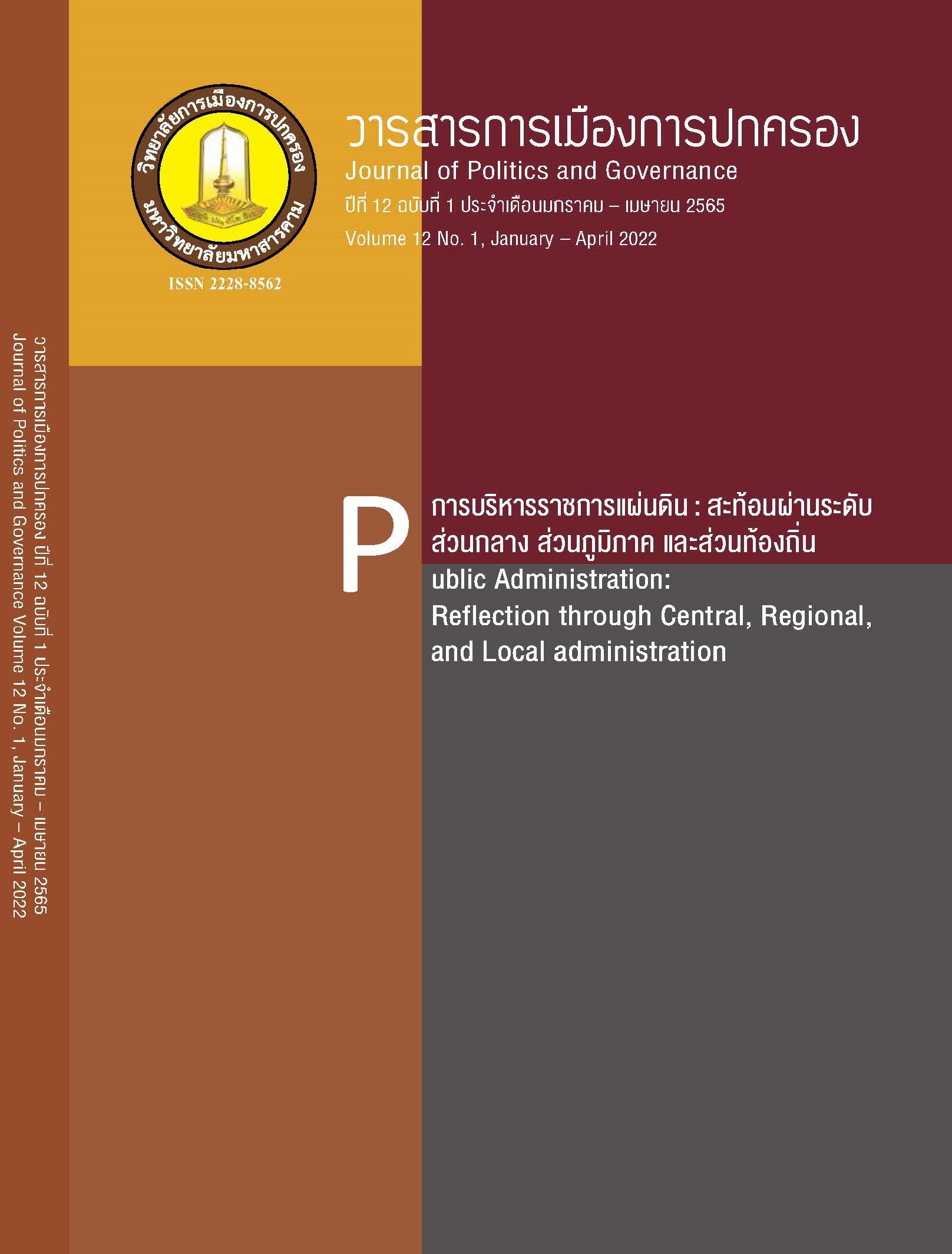Developments of Policy on Providing Access to Antiretroviral Therapy and the Impacts of Policy Change: from Limited Access to an Era of Free Treatment in Thailand
Main Article Content
Abstract
Thailand had the highest HIV prevalence in Southeast Asia. As time went by, the country was able to fix the problems of HIV/Aids infection which was praised by the World Health Organization (WHO) and United Nations (UN). With the ability to contain Aids epidemic, Thailand had become a role model to fight against HIV/Aids infections for many countries around the world. One of the Ending Aids policy was providing access to antiretroviral therapy. This research was an academic article utilizing historical documents published during 1992 – 2018. Its purposes were to explain the developments of policy on providing access to antiretroviral therapy in Thailand during 1992 – 2018 and present the impacts caused by policy change. Thailand’s developments of policy on providing access to antiretroviral therapy could be divided into five stages: 1) moving to the national agenda, 2) reducing dependence on foreign organizations, 3) targeting specific groups, 4) allowing access to HIV/Aids medicine during pre-exposure prophylaxis, and 5) role of the member of the Thai royal family in policy formulation. The public policy process was concerned with the following components: policy formulation, policy adoption, policy implementation, policy evaluation, and policy improvement or policy change. However, theoretical gap was found to be the impacts of policy change. The article presented such impacts caused by policy change. The empirical results revealed that when each policy on providing access to antiretroviral therapy was changed, the number of HIV/Aids infected people getting access to the antiretroviral therapy increased significantly. Therefore, it was recommended that “impacts of policy change” be added as another component of public policy process.
Article Details
References
กลุ่มพัฒนาวิชาการ สำนักงานป้องกันควบคุมโรคที่ 3 จังหวัดชลบุรี. (2556). ประสิทธิผลการพัฒนากลไก ประสานงานการป้องกันและแก้ไขปัญหาเอดส์ ในพื้นที่สำนักงานป้องกันควบคุมโรคที่ 3 จังหวัดชลบุรี. สำนักงานป้องกันควบคุมโรคที่ 3 จังหวัดชลบุรี.
คณะกรรมการแห่งชาติว่าด้วยการป้องกันและแก้ไขปัญหาเอดส์. (2560). ยุทธศาสตร์แห่งชาติว่าด้วยการยุติปัญหาเอดส์ พ.ศ.2560-2573. ศูนย์อำนวยการบริหารจัดการปัญหาเอดส์แห่งชาติ สำนักโรคเอดส์ วัณโรคและโรคติดต่อทางเพศสัมพันธ์ กรมควบคุมโรค กระทรวงสาธารณสุข.
สำนักงานปลัดกระทรวงสาธารณสุข. (2563, 15 พฤษภาคม). พระเจ้าวรวงศ์เธอ พระองค์เจ้าโสมสวลี กรมหมื่นสุทธนารีนาถ เสด็จมาทรงปฏิบัติพระกรณียกิจด้านการป้องกันเอชไอวีในภูมิภาคเอเชียและแปซิฟิก ณ กรุงเนปยีดอ สาธารณรัฐแห่งสหภาพเมียนมา. สืบค้นจาก https://pr.moph.go.th/?url=pr/detail/2/04/139904/
สำนักงานหลักประกันสุขภาพแห่งชาติ. (2561, 25 กันยายน). บริการข้อมูลข่าวสารสารสนเทศการให้บริการผู้ติดเชื้อเอชไอวี. สืบค้นจาก http://napdl.nhso.go.th/NAPWebReport/.
สำนักโรคเอดส์ วัณโรค และโรคติดต่อทางเพศสัมพันธ์ กรมควบคุมโรค กระทรวงสาธารณสุข. (2547). แนวทางการดูแลผู้ติดเชื้อเอชไอวีและผู้ป่วยเอดส์อย่างครบวงวรและต่อเนื่อง พ.ศ. 2547. กระทรวงสาธารณสุข.
______. (2557). แนวทางการตรวจรักษาป้องกันการติดเชื้อเอชไอวี ประจำปี 2557. กระทรวงสาธารณสุข.
______. (2561). แนวทางการจัดบริการการป้องกันก่อนการสัมผัสเชื้อเอชไอวีในประชากรที่มีพฤติกรรมเสี่ยงต่อการติดเชื้อเอชไอวี ประเทศไทยปี 2561. สำนักโรคเอดส์ วัณโรค และโรคติดต่อทางเพศสัมพันธ์ กรมควบคุมโรค กระทรวงสาธารณสุข.
สำนักวัณโรค กรมควบคุมโรค กระทรวงสาธารณสุข. (2558). โครงการยุติปัญหาวัณโรคและเอดส์ ชุดบริการ. สำนักวัณโรค กรมควบคุมโรค กระทรวงสาธารณสุข.
สุพัตรา ศรีวณิชชากร, บังอร เทพเทียน, พักตร์วิมล ศุภลักษณศึกษากร, กุมารี พัชนี, และภูษิต ประคองสาย. (2557). วารสารวิชาการสาธารณสุข, 23(1), 162.
หมอชาวบ้าน. (2550, 16 ธันวาคม). ผู้ติดเชื้อเอชไอวี/เอดส์ ในระบบหลักประกันสุขภาพถ้วนหน้า. สืบค้นจาก https://www.doctor.or.th/clinic/detail/7480.
Adam Oliver & Elias Mossialos. (2004). Equity of access to health care: outlining the foundations for action. Journal Epidemiol Community Health. 58, PP. 655-658. doi: 10.1136/jech.2003.017731
Alexandre Grangeriro, Lucina Teixeira, Francisco I. Bastos & Paulo Teixeira. (2006). Stainability of Brazilian policy for access to antiretroviral drugs. Revista de Saúde Pública. 40 (Sup). pp.1-10. Retrieved from http://dx.doi.org/10.1590/S0034-89102006000800009.
Antiretroviral Treatment in Thailand. United Nations Development Programme.
Cristian Timmermann and Henk van den Belt. (2013). Intellectual Property and Global Health: From Corporate Social Responsibility to the Access to Knowledge Movement. Livepool Law Rev. Springer, 34, 47-73.
Jacqineau Azetsop & Blondin A Diop. (2013). Access to antiretroviral treatment, issues of well-being and public health governance in Chad: what justifies the limited success of the universal access policy?. PHILOSOPHY, ETHICS AND HUMANITIES IN MEDICINE. 8:8. Retrieved from http://www.peh-med.com/content/8/1/8
James E. Anderson. (2011). Public Policymaking. Boston: Wadsworth Cengage Learning.
Sarada P. Wast, Padam Simkhada, Julian Randall, Jennifer V. Freeman and Edwin van Teijlingen, (2012). Factor Influenceing Adherence to Antiretroviral Treatment in Nepal: A Mixed- Methods Study. Plos ONE. 7(5), May.
Sophie Desmonde, Franck Tanser, Rachel Vreeman, Elom Takass, Andrew Edmonds, Pagakro Lumbiganon, Jorge Pinto, Karen Malateste, Catheine McGowan, Azar Kariminia, Marcel Yotebieng, Fatoumata Dicko, Constantin Yiannoutsos, Mwangelwa Mubiana-Mbewe, Kara Wools-Kaloustian, Mary-Ann Davies, and Valeriane Leroy. (2018). Access to antiretroviral therapy in HIV-infected children aged 0-19 years in the International Epideminology Database to Evaluate AIDS (IeDEA) Global Cohort Consortium, 2000-2015: A Prospective cohort study. POLS MEDICINE. 15(5) May 4. Retrieved from http://doi.org/ 10.1371/ journal.pmed.1002565.
The Global Network of People Living with HIV(GNP+). (2013). Access Challenges for HIV Treatment among People Living with HIV and Key Population on Middle-income Countries. Policy Brief, October 2013. The Global Network of People Living with HIV (GNP+).
UNAIDS. (2018). FACT SHEET 2018. UNAIDS. Switzerland: UNAIDS.
______. (2518). HIV and AIDS Estimates. (February, 10, 2020) Retrieved from https://www.unaids.org/en/regionscountries/countries/thailand.
United Nations Development Programme. (2017). The Journey Of Universal Access to Antiretroviral Treatment in Thailand. Retrieved from https://www.th. undp.org/content/thailand/en/home/library/hiv_aids/the-journey-of-universal-access-to-antiretroviral-treatment-in-t.html
World Health Organization Thailand. (2018). HIV and AIDS. (December 13, 2018). Retrieved from http://www.searo.who. int/thailand/areas/hivaids/en/
World Health Organization. (2011). World Health Organization brief on Antiretroviral Treatment (ART) in and TB prevention. January, 2011. Switzerland: World Health Organization.


